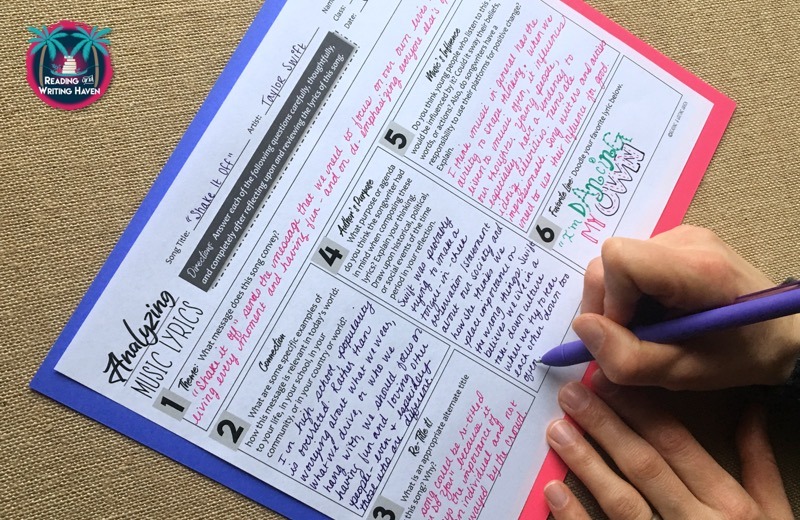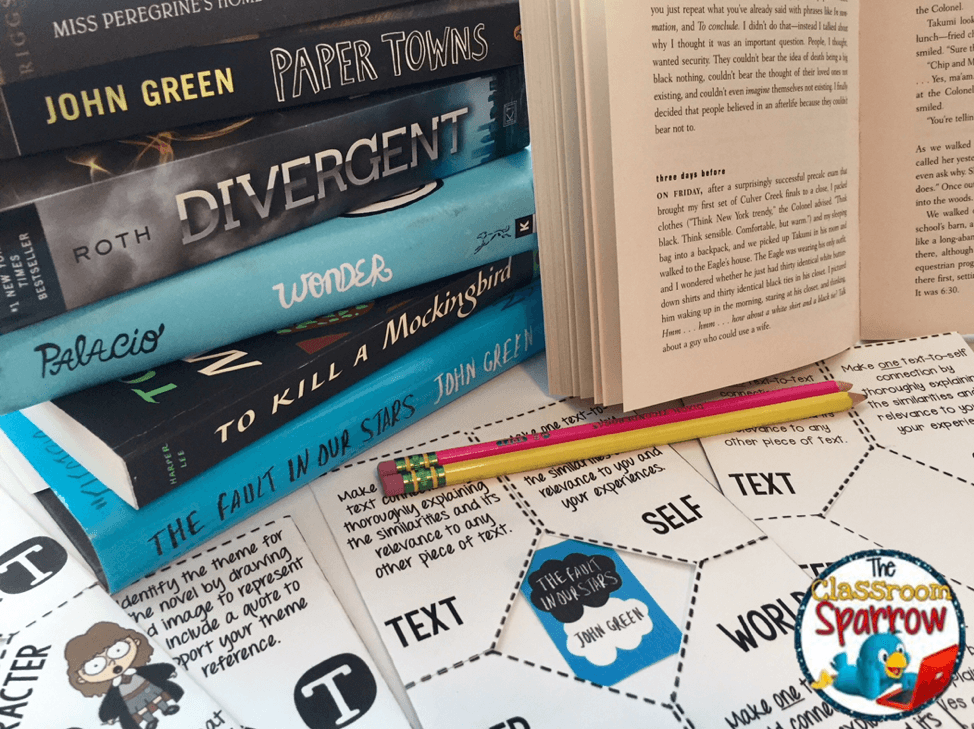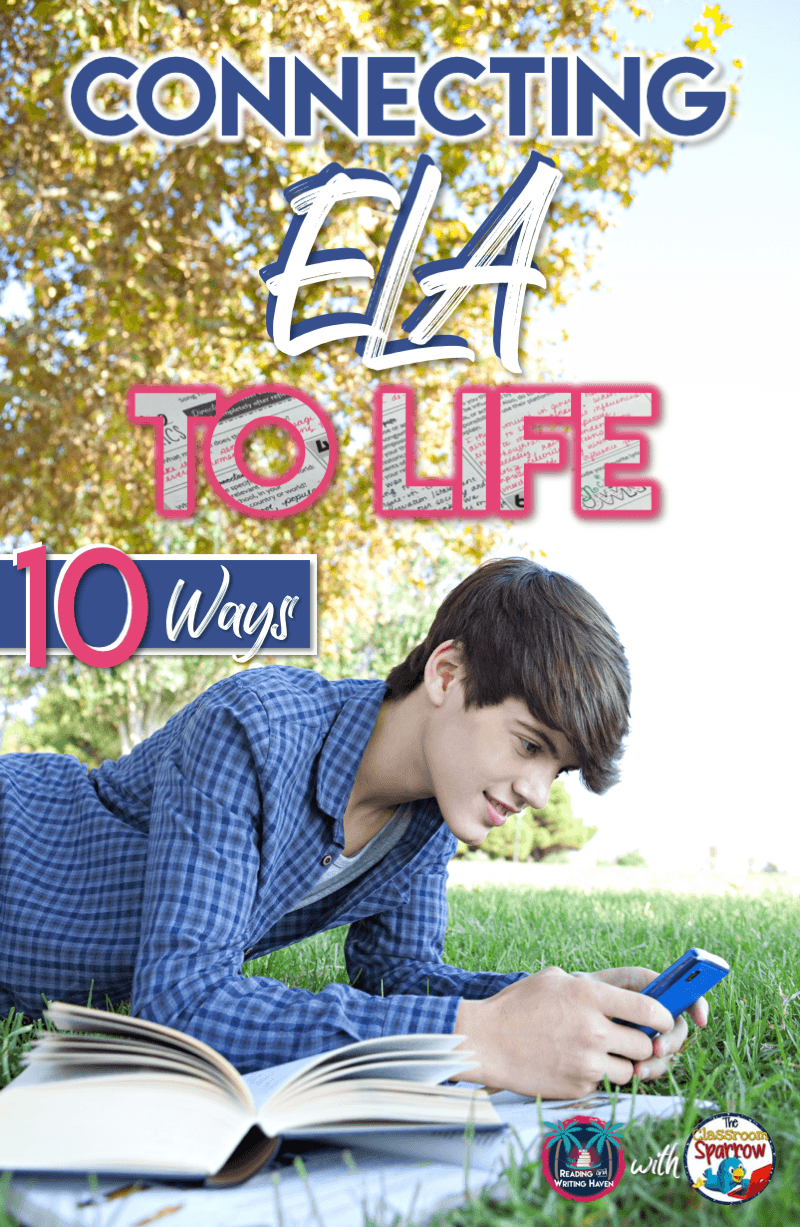10 Ways to Connect ELA to Real Life
Students will buy into lessons when they can see their relevance. Connecting ELA to real life can take some careful thought and planning, but it’s fun, and it’s worth the time and energy. In today’s blog post, The Classroom Sparrow and I have partnered to provide some specific ideas. Keep reading to be inspired with ten different ways we can relate course content to what students care about in meaningful ways.
THEMATIC CONNECTIONS
SHAKESPEAREAN THEMES. Ah! The dreaded Shakespeare unit. I can hear my students complaining already. One of the easiest ways to convince my students that Shakespeare is still relevant is by showing them that many of his themes are applicable to today’s society. While the stories were written a long time ago, the themes are timeless: love, friendship, fear, ambition, etc. While students may have a tough time reading some of his work, they will definitely be able to connect to many of his themes. In turn, they will have a better understanding of the characters. If you or your students aren’t sold on the idea of including at least one Shakespeare text as part of your course, check out a blog post I wrote about learning to love Shakespeare. It might convince you (or them!) to give it a try! (The Classroom Sparrow)
POETRY AND MUSIC. There’s no better way to teach theme than by listening to music and reading poetry with students. Choose your favorite song, and pair it with a poem students are required to study for your class. Or, use music as a hook for a poetry unit. Once students understand that music truly is poetry, it tends to have less of a negative stigma. Here is a free analyzing music to teach poetry resource you can use tomorrow! (Reading and Writing Haven)
RESEARCH PROJECTS FOR THE REAL WORLD
PASSION PROJECTS. Engage students in real-life learning by allowing them to take control of their research project. This year, I experimented with my first formal passion project assignment. In the past, my students have participated in multi-genre research projects, which are very similar. This year, my students wrote an argumentative research paper. In addition, I gave my 7th grade students the opportunity to complete an extension project based on their passion. The results were amazing. Why? They had the freedom to connect what they were learning in class to what they care about in the real world. (Reading and Writing Haven)
CAREER EXPLORATION. Another strategy that I regularly use in my English classes is the incorporation of career-exploration activities. Career-related activities are a simple way to make an activity relevant because everyone, at some point in their life, needs a job! Students actually enjoy this unit because everything is about them. For this reason, I created this Career/Job Exploration Research project. The purpose of this project is to allow students to explore a career of interest. By the end, they have a pretty good idea if the career they chose to research is something they will want to eventually explore. It’s a great way to get them thinking about their future. (The Classroom Sparrow)
REAL LIFE READING STRATEGIES
MAKE CONNECTIONS. Initially, students may find it difficult to connect with a text, especially if it is a classic of set in a period a long time ago. However, once they have a guide to help them make those connections, the relevance is a lot easier for them to see. I created this FREE Reading Connections Interactive Foldable to help my students connect with a variety of elements as they read. It helps students to organize their text-to-text connections, text-to-self connections, text-to-peer connections and text-to-world connections. In their connection write-ups, students have to clearly identify the connection, provide a specific example of the connection from the text, then explain the “so what” of that connection. This three-step process will help to ensure that their connections are not superficial. (The Classroom Sparrow)
ANALYZE MODERN TEXTS. I like to introduce my students to analyzing by selecting texts they would commonly encounter outside of class. While not all students pick up a novel and read at home (sadly!), all students encounter texts. Short films, commercials, news articles, political cartoons, songs – teachers need to show students how to analyze these nontraditional texts intelligently. Yes, we analyze in school, but analyzing is also an important reading strategy in life. (Reading and Writing Haven)
RELEVANT LITERATURE AND CHOICE
BOOK CLUBS. I just can’t say enough about how book clubs have improved students’ attitudes toward reading in my classroom. If connecting ELA to real life is our goal, book clubs mimic a real life format for enjoying literature. They allow for choice, socialization, and learning. I wrote a whole blog series about how book clubs are a meaningful approach to choice reading. (Reading and Writing Haven)
LITERATURE CIRCLES. When I do a novel study in my class, I usually select 3-4 books to make groups manageable and realistic. When selecting books, I do my best to pick out at least two current and popular YA books (especially for readers who may be a bit more reluctant). Some examples include The Fault in Our Stars, Miss Peregrine’s Home for Peculiar Children, and Wonder. I try to select at least one classic novel (for the avid readers looking to broaden their reading repertoire), such as To Kill a Mockingbird, Of Mice and Men, and The Great Gatsby. Finally, I try to select least one book choice that male readers would enjoy, like The Outsiders, A Long Way Gone, and The Lightning Thief. While you’re not going to hit every interest level every time, I found offering a few novel choices a great way to involve students in their learning. Ultimately, it ensures the books they choose to read are relevant to their lives and interests. (The Classroom Sparrow)
WRITING FOR THE REAL WORLD
WRITING PROMPTS. Another fun strategy that I use in my English classes are daily writing prompts. First, they help establish a routine, and secondly, students practice many ELA skills while working on the writing prompts without even knowing: reading, writing, and speaking. I try to create and post prompts that are current to their life (books of interest, movies of interest, pop culture happenings, events that may be occurring in our community or school, etc.) You can begin the class by displaying a prompt on a smart board or by simply writing it on your whiteboard. Then, have the class share their opinions verbally before writing out their response on a piece of paper. These do not necessarily have to be graded for marks, but they definitely can be. (The Classroom Sparrow)
EMAIL SKILLS. I always teach my students email etiquette. Ever since I came to the revelation that students were sending me rude emails because they just didn’t know any better, it’s been a priority. Students care more about writing assignments when they can see the real-life application. Connecting ELA to the real world can be as simple as teaching students how to email a teacher, a boss, or anyone else (respectfully!). Can you relate? Read more about how I teach email etiquette. (Reading and Writing Haven)
Making ELA relevant is critical in our twenty-first century classrooms. In order to reach students, we need to be connecting ELA to real life. If you’re looking for more teaching inspiration, you’ll want to read this sister post: 10 Meaningful Ways to Wrap Up Your School Year.
[sc name=”mailchimp1″]




This was awesome, thank you!
You’re welcome, Ana! Glad to hear this information is helpful for you. Enjoy the rest of your school year!